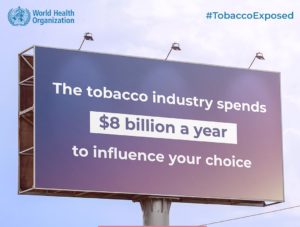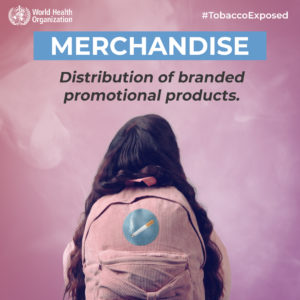Why does this year’s World No Tobacco Day matter to children?
By: Atul, Grade X, Chennai, India
Every year, 31 May is observed as World No Tobacco Day by the World Health Organization (WHO) and this year’s theme is ‘protecting youth from industry manipulation and preventing them from tobacco and nicotine use.’ While we are currently fighting the pandemic Covid-19, three decades ago, Gro Harlem Brundtland, the then Director General of WHO said, “The tobacco pandemic is a communicated disease. It is communicated through advertising … to which non-smokers – especially children – are exposed” (WHO, 1991). Hence protecting children from tobacco companies’ strategies to lure children to smoke is urgent.
It is not without a reason that tobacco companies target children. Studies have shown that a majority of smokers begin before the age of 18 years and hence it is logical that tobacco companies target children. In India more than 625000 children (10-14 years old) smoke everyday (Tobacco Atlas).[1]
Considering how it becomes easier to target children, tobacco companies take advantage of children’s underdeveloped, impressionable brains and their lack of ability to make crucial decisions, in order to sell their products. The prefrontal cortex is the part of the brain that deals with the process of decision making. A study by [2]Kurt W Fischer, Daneil Bullock states the prefrontal cortex develops until the age of 25. This implies that during the adolescent years of a person, their prefrontal cortex is still underdeveloped and incapable of making crucial choices. Further, a study by [3]Debra Bradley Ruder has revealed that the adolescent brain has both fast growing synapses and sections that remain unconnected. This structure leaves adolescents to be easily influenced by their environment, more prone to impulsive behavior and addiction. Taking this into advantage, tobacco companies target children through different means – direct advertising, indirect marketing, promotional activities etc.
 However, the strategy used by tobacco companies that is often overlooked and seems to be innocent at heart are the other ventures of tobacco companies – stretching their brand beyond tobacco. Let us take the example of India Tobacco Company Limited (ITC), the biggest tobacco company in India. ITC has products to supply in almost every sphere of demand imaginable [4] food (from atta to noodles to candies), personal care products (perfumes, antiseptic, shampoo), stationery that children use, hotels etc. In fact, now in the context of Covid-19, ITC positioned itself as a concerned grocer, teaming up with Dominos Pizza to deliver essentials at our doorsteps.
However, the strategy used by tobacco companies that is often overlooked and seems to be innocent at heart are the other ventures of tobacco companies – stretching their brand beyond tobacco. Let us take the example of India Tobacco Company Limited (ITC), the biggest tobacco company in India. ITC has products to supply in almost every sphere of demand imaginable [4] food (from atta to noodles to candies), personal care products (perfumes, antiseptic, shampoo), stationery that children use, hotels etc. In fact, now in the context of Covid-19, ITC positioned itself as a concerned grocer, teaming up with Dominos Pizza to deliver essentials at our doorsteps.
It is worth noting that a lot of their products are either used by children or in their household everyday. This is no coincidence. People may argue stating that the children are only using things that are a necessity to them and how is this related to tobacco consumption? There is a psychological phenomenon called “brand recall.” Brand recall coming from brand awareness, is one of the most important dimensions of brand equity, is often considered to be a precondition of consumers’ buying decision, and represents the main aspect for including a brand in the consideration set.[5]
 Therefore all the products we use that have the brand logo of a tobacco product give us a positive impression of the logo and everything it sells. Our subconscious will have a positive impression on the tobacco products sold by said company, only because we use so many of their other products on a daily basis that we think are of good quality and it is a trusted brand. This is also why the tobacco industry continues to do large charity work and create a positive public image. The better their brand image is, the better their customers’ brand recall will be. Moreover, if they targeted children, they have recruited loyal customers for their brand in future.
Therefore all the products we use that have the brand logo of a tobacco product give us a positive impression of the logo and everything it sells. Our subconscious will have a positive impression on the tobacco products sold by said company, only because we use so many of their other products on a daily basis that we think are of good quality and it is a trusted brand. This is also why the tobacco industry continues to do large charity work and create a positive public image. The better their brand image is, the better their customers’ brand recall will be. Moreover, if they targeted children, they have recruited loyal customers for their brand in future.
Another dangerous tactic the tobacco companies have considered is to make tobacco accessible to children. What better place to target children than schools and colleges? From what I have observed in Chennai city, there have been at least 3 to 4 shops within 100 yards of educational institutions that sell tobacco products. According to COTPA (Cigarettes and Other Tobacco Products Act),[6] the sales of any tobacco product within a 100 yard radius of any educational institution is banned. This law is broken on a daily basis by multiple local vendors. An investigation by Reuters found that tobacco companies paid kiosks a monthly fee for advertisements and product displays and the location of the kiosk is a key determining factor.[7]
This battle between us and the tobacco companies will go on for years, because targeting children started way back in the 1950s by tobacco companies. Until then we could make small, yet crucial steps that will help us in the long run. Schools and colleges should avoid the use of any product marketed by tobacco companies (including stationery); the government should implement COTPA provisions strictly, punishing all those who sell tobacco products within 100 yards of educational institutions. Everyone should boycott tobacco companies, by refusing to buy any and all products that share their logo with a cigarette. Families should explain to their children about the perils of tobacco consumption in order for them to understand why we shouldn’t consume them. This will kill their curiosity related to tobacco consumption, which is the first and definitely the most crucial step toward a tobacco free generation. Most importantly, the Government should include legal measures to protect children from tobacco companies manipulation.
[1] https://files.tobaccoatlas.org/wp-content/uploads/pdf/india-country-facts-en.pdf
[2] https://www.ncbi.nlm.nih.gov/books/NBK216774/
[3] https://harvardmagazine.com/2008/09/the-teen-brain.html
[4] https://www.itcportal.com/brands-microsite/
[5] https://www.ukessays.com/essays/marketing/association-between-brand-recall-and-consumer-purchase-intention-marketing-essay.php
[6] https://www.tobaccocontrollaws.org/legislation/country/india/summary
[7] https://www.reuters.com/investigates/special-report/pmi-india/
Short Autobiography from Atul
As a part of my class 9 academic requirement, I had to do 20 hours of socially useful and productive work (SUPW). I chose to work with an NGO called MACT (Mary Anne Charitable Trust). They work towards creating a smoke-free generation and educate children about the ill affects of tobacco consumption.
During my SUPW. I became a member of their programme called CAT (Children Against Tobacco). After I finished my SUPW, I became a volunteer for MACT and a mentee of Mr. Cyril Alexander (founder of MACT), a well known anti tobacco activist in India.
The more I volunteered with MACT, my interest and knowledge of the subject grew. It was during this time I learnt most about the ill effects of tobacco products. Incidentally, I could also relate it to losing my grandfather to tobacco induced lung cancer and the struggles he went through.
Now I’m more than convinced that I want to be involved in working towards a tobacco free world. I’ve also started mapping the availability of tobacco products within 100 yards of educational institutions. This has come to a pause due to COVID-19. I’m hoping to continue it as soon as possible.